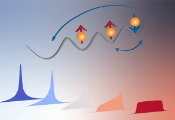Quantum Effects Make Electrons Superconduct while Standing Still
In an isolated atom, electrons occupy orbitals with different energy levels. When the orbitals come together in a solid form, they merge into energy bands. The dispersion in energy of these bands depends on the arrangement of the atoms and the way the electrons move and interact with each other. A small energy dispersion, also called flat band, indicates electrons that have very low velocity but that interact very strongly through their Coulomb repulsion. This type of band structure can be found when two layers of graphene are twisted relative to each other. At precise twist angles, known as magic angles, the layers of graphene will exhibit flat bands and unconventional electronic properties, including superconductivity. However, theory says these flat bands should be incompatible with superconductivity. In fact, electrons that move so slowly should not conduct electricity at all.
In this work, researchers investigated what causes superconductivity in twisted bilayer graphene. The current theory of superconductivity, the Bardeen-Cooper-Schrieffer (BCS) theory, cannot explain materials that are superconducting at temperatures far above absolute zero degrees. This is a great unsolved problem in physics. The presence of superconductivity in twisted bilayer graphene, with its very slow electrons, shows that scientists need to modify the BCS equations. The equations must include the geometry of the space where the quantum electrons live. This finding offers new directions in the search for materials that superconduct at high temperatures. These superconductors would enable important real-world applications, such as electric transmission lines that lose almost no power.
In 2018, researchers discovered superconductivity in a bilayer made of graphene layers rotated by a specific angle of 1.08 degrees. Now, in this study, researchers have realized this magic angle with great precision. This resulted in the slowest-moving electrons among all graphene systems. Surprisingly, the system is still superconducting despite the slow-moving electrons. One of the challenges of this study was to accurately measure the velocity of such slow-moving electrons. The researchers leveraged for the first time an effect predicted in particle physics, the Schwinger effect, in which electron-positron pairs are created spontaneously in the presence of an electric field. They found that in twisted bilayer graphene the main contribution to superconductivity is not given by the kinetic energy of the electrons, as previously thought. Instead, a quantum property of the electron system, called quantum geometry, sets the scale of the superconducting response, resolving the paradox.
Electrons are both particles and waves, and the term quantum geometry refers to the shape of the wave component (wavefunction) and the way the electron wavefunctions connect and interlink. In twisted graphene, the connections among the electron wavefunctions are more important than the electron velocities. These insights provide new principles for revising the BCS theory and for accelerating the discovery of superconductors that can operate at high temperatures.




































